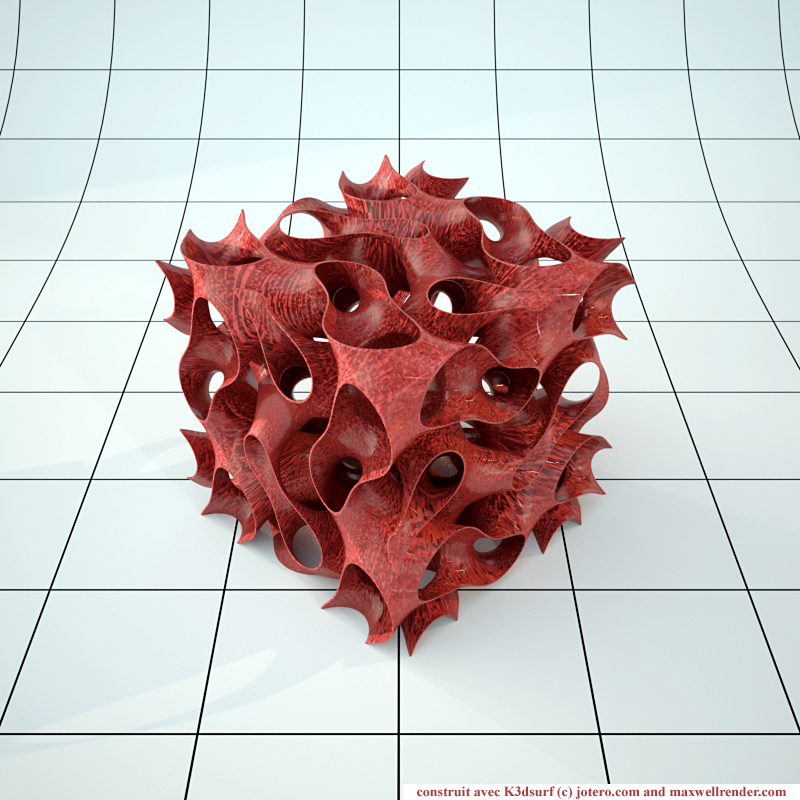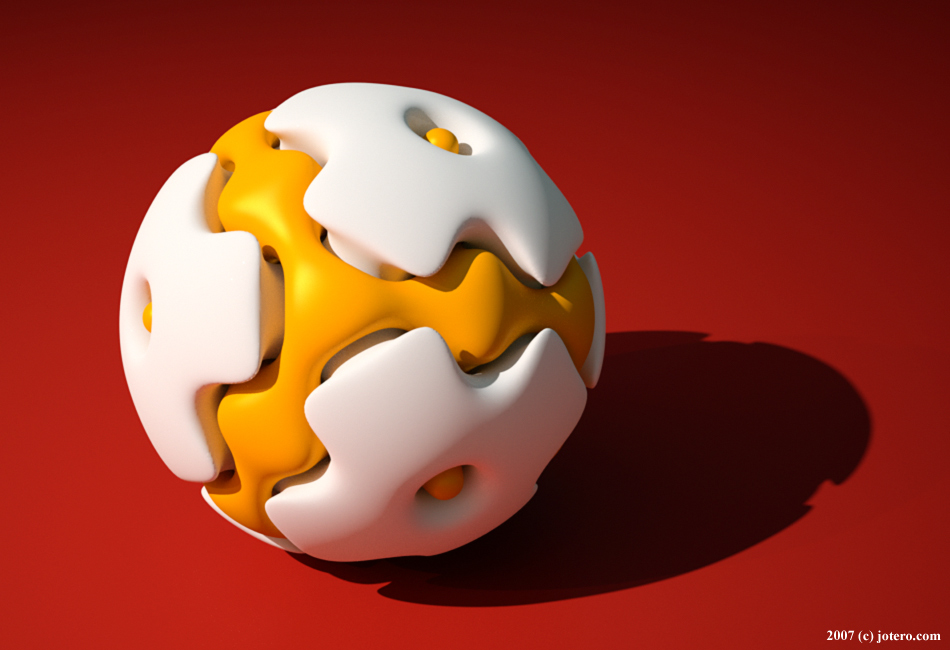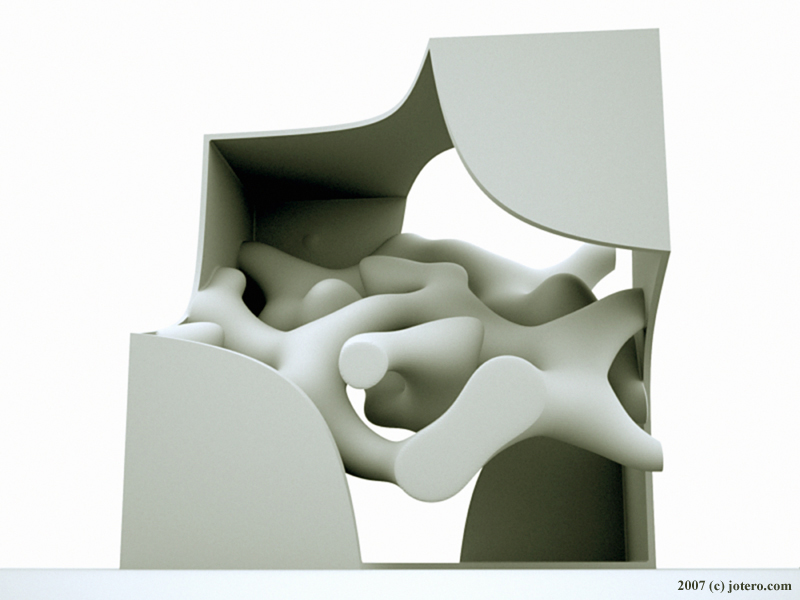Renderosity Forums
Search Results: Threads
1 threads found!
| Thread | Author | Replies | Views | Last Reply |
|---|---|---|---|---|
| nextstep | 26 | 2857 |
Search Results: Comments
11 comments found!
Thread: Mathematic modeling? | Forum: 3D Modeling
Attached Link: Download:
Hi, Where can I find screenshots for this plugin? Also, K3DSurf-0.6.1 is out and now it uses an integraded OpenGL viewer that make it far faster than before in manipulating height resolution mathematical models. An interesting new features : Isosurfaces morph effect! I don't know about a software that can make Isosurfaces morph effect with only...0% of CPU usage, but K3DSurf can even at full screen mode (1600x1200). You need however an OpenGL based graphics card but a 6 yers old ATI radeon9000 can do easily the job . If you know some software (even commercial) that can match this feature , please let a message. Cheers, TahaThread: Mathematic modeling? | Forum: 3D Modeling
Hi,
Delanauy triangulation is a well known algorithme for terrin modelling. You can found some ressources here (Librarys that you can use in your own software if you are a programer):
http://local.wasp.uwa.edu.au/~pbourke/modelling/triangulate/
http://www.ncgia.ucsb.edu/conf/SANTA_FE_CD-ROM/sf_papers/lattuada_roberto/paper.html
http://www.mathtools.net/C_C__/Computational_geometry/
http://www.cgal.org/Manual/3.2/doc_html/cgal_manual/Triangulation_3/Chapter_main.html
www.vtk.org/
or some softwares :
http://www.comp.nus.edu.sg/~shixinwe/software.htm
http://www.qhull.org/
I'll chech for other softwares and let you know.
Thread: Mathematic modeling? | Forum: 3D Modeling
Thank you for the link...It's worthy to see all theses mathematical creations. Caraca is trully fabulous for drawing parametric eqautions and for visualising textured mathematical objects. K3DSurf can also draw parametric equations but also Isosurfaces (since the last version). The minimal surfaces is a challenge for me now and doing it will be a great achievement but for the moment I'm working to improve the parametric and Isosurfaces drawing (it's sufficient for 99.99% of the need of the commun people ;-))
Thread: Mathematic modeling? | Forum: 3D Modeling
Quote - Good luck with your software, i
m looking forward to it. (ill go at sourcefourge when i`m back home)
Thanks :).
I found this about ProEngineer (http://en.wikipedia.org/wiki/ProEngineer) and this (http://en.wikipedia.org/wiki/Parametric_feature_based_modeler) :
" Parametric feature based modelers use change states to maintain information about building the model and use Lisp expressions to constrain associations between the constructive solid geometries. "
It seems that it has some interesting features related to the mathematical modeling...however, apparently it's using an internal representation of it's objects so I can't tell if it's a "pure" mathematical modeler (in the sense that a mathematical description can be put down in a paper)!
A mathematical object is nothing more than a set of a mathematical fuctions along with the limits where they are defined so, for me, the purpose of a mathematical modeler is to generate this mathematical description. Also, there is a lot of mathematical reprentations (parametrique, iso, minimal...) and the quality of mathematical modeler may depend on how many of theses methods it uses and how it did it : K3DSurf for instance uses two techniques (Parametric and Iso).
To resume, a mathematical modeler is a "functions generator" rather than an "object generator". In fact, every object we can think about IS a mathematical object, knowing it's mathematical description is another story... We can do some mathematical modeling by taking some easy mathematical object (sphere, cube,...) and rise there complexitys by applying some simple transformations( this is what I'm calling "Morph effect") or construct theme from a low level mathematical object (example : surface generation from curves in "Carrara studio", "http://www.3dvf.com/modules/publish/Logiciels_259_1.html", thanks SHONNER) ...
K3DSurf is trying to implement some of theses technics but as I sayed before, the way is still long but I hope at least to catch the interest of some of you ;-)
Taha
Thread: Mathematic modeling? | Forum: 3D Modeling
Imaging now that we have a mathematical modeler capable of generating mathematical objects representing some life-like creatures...what's the new thing that we can do with theses objects?
The first implication will appear in our way of making movies and games: Our computer screens and televisions will be a true "windows" in some life-like scenes and not only a display of a set of successives frames made by human. Take an example of a game where all scenes are described mathematiclly, we can imagine (and it's easy to conceive even with the power of today's computers) that you can "zoom" in every direction of your scene without any pixelisation problem or degradation of the resolution: it's like looking by a window with a super binoculars that doesn't have a resolution limitation (in some ways, it's better than in real life where theses plaything are limited by our pocket , humain senses and physics laws).
The actual way of making movies use a frame by frame techniques. Thoses frames are pre-made and assembled (movies like "Shreck") or made in real time (today games). Today's games are half way from what I'm talking about because they are suffering from the resolution problem ( because the design of scenes is done by humain). Computers have the power of calculation at the speed of light, so they can do the design in real-time (if we give them the the appropriate scenes that they can understand ). In fact, creating a mathematical scene is nothing more than creating a synthetic world limited only by the number of creatures you put inside : unlike today's movies, we can look at the same scene but everyone can monitor it's prefered subject in the scene.
Right now I 'm talking only about the implication of the "resolution" advantages...but there is a much much more interesting implication that we can easily foresee : the description of our scene is made by mathematical functions, we can easily put inside some mathematical functions that describe interactions between theses objects... In other words, theses movies doesn't have a limitation time and there history can "evolve" !! It's likely that you can never predict the behaviour of your creations after certain mount of time...they can evolve and learn things that you didn't imagine as consequence of your earliest creations.
Mathematical functions can easily "talk" to mathematical objects and our movies are in fact some mathematical "system" that we know we can hardly predict at a very low level so imaging a scene of 20 or 30 caracters. Mathematical scenes are far easy to use to create an evolving synthetic and impredictible world and that will probably be the most interesting thing in this way of thinking.
I think that our future is made by us and is limited only by our lack of imagination 
Thread: Mathematic modeling? | Forum: 3D Modeling
Quote - > Quote - If this were 2D I'd say that's pretty much how vector objects are described... So going to 3D, wouldn't this be comparable to a nurbs way of doing things?
Or am I missing something?
Well, NURBS, and any B-splines for that matter, generate a large set of points in space based on a mathematical relationship between a small set of control points. This program generates the points on a surface from a mathematical relationship over a range of coordinate values, so there are strong similarities.
However, in practice, they are really polar opposites. When you use a program with a NURBS implementation (say, Rhino, or Blender), you manipulate the surface visually, with the numeric ranges being secondary or unimportant. With this type of program (K3DSurf itself, or something like POV-Ray) you can work with the numbers and their mathematical relationships primarily, with the resulting visualization coming in second.
It's very appealing to numbers geeks like myself.
Captain Jack
That's an accurate resum (Thanks Captain Jack) 
Also, one of the biggest difference between a mesh modeler (Blender,...) and a mathematical modeler is that the first one generate a mesh file composed of numerical data (points coordinates in 3D space) where the second generate only a set of mathematical functions, that you can use to generates 3D points by choosing your prefered resolution accuracy.
The mathematical modeling is, I think, the only way of using the power of computers to do the hard job of the designer: humain can only feal the "real world" and it's creatures (that's why our design is limited by our senses), the computer in other hand can understand and feal mathematical objects and can generate for us humain a 3D approximations of theses objects... The idea is then simple : if we can describe our creations by mathematical formulas (the only way of understanding of computers), then the computer can give us a 3D approximations of theses objects that we can never do because of it's power calculation that we don't have... There is also others advantages and implications unkown right now that will arise with the spread of this way of thinking.
It's sounds like a Fiction science but it's trully possible to use our computers to do some design for us 
Taha
Thread: Mathematic modeling? | Forum: 3D Modeling
Quote - There are an awful lot of really interesting surfaces that can be created mathematically, many of which would make a great starting point for life-like objects. Captain Jack
That's it! I can't said better than this to describe what I feel!
Thanks
Thread: Mathematic modeling? | Forum: 3D Modeling
Quote - I do agree that your 'new' aproach to modeling is interesting. I also agree on the 'mathematics can be fun' statement on your website.
Thanks, we have the same feeling then.
Quote - But... I must admit I feel kinda weird about this development. Genius programmers around the world have developped software that allows us to model both ways; either freely in a virtual 3D space, dragging points and polygons with our mouse; or mathematical by numerics, adjusting point and poly positions on a numeric basis.
I do agree that there is already genius software for doing 3D modelling, but did they generate mathematical equations for there creations? You said "adjusting point and poly positions on a numeric basis", that's in fact the way of the actual modelling, some sort of "approximation", no pure mathematical shapes where the connections are perfectlly defined by mathematical formulas. The first rule in mathematical modelling is, and it can sound weird : We don't talk about defined points in 3D space, nor polygones, because they are only approximations of our mathematical objects which are free from any approximations: The picture showing the half of your face and an approximation of it is a good example to use here : the mathematical formulas are like the surface of your face, it can't be fully defined by some approximations points because we need an infinite number of them.
I was working in a mathematical viewer, then I realised that the shapes can be used in 3D scenes. I was shortlly after looking for new mathematical shapes (for use in 3D scenes) but it was hard to find them in the net or create them by hand. I found that some mathematical transformation can be applied directly to my formulas to make some easy transformations (twist and scale ). There is also some ways to create mathematical formulas for surfaces by using the mouse: The idea of creating mathematical formulas for every generated shape was since then in my head! The idea is simple but it seems that no one take it seriouslly
Quote - Either way, they made sure we could focus on modeling cool stuff without having to worry about the sine, cosine, tangent, cotangent and the other -angents. That's actualy why computers where developped, to take care of those calculations for us...
You'll not have to worry about sine, cosine and other -angents  , because the software will be able to generate the formulas for you! The way of modelling is the same like the one you're used to, the only difference is that you'll probablly not have all the features available for the mesh modellers.
, because the software will be able to generate the formulas for you! The way of modelling is the same like the one you're used to, the only difference is that you'll probablly not have all the features available for the mesh modellers.
Quote - Don't get me wrong, I do think this is a cool idea that may become a new way of modeling in certain areas like medical stuff or nasa projects, where mathematical accuracy is crucial, but as a self proclaimed 'artist' that goes by his intuition, creativity and often cheer old providence while creating stuff, this kind of modeling would kinda take the fun out of it...
Thanks for the advice but right now I still have fun with it and hope to make others to feel the same 
Quote - Anyhow, I sincearely wish you all the best with your project! Mike
Thanks.
Taha
Thread: Mathematic modeling? | Forum: 3D Modeling
Quote - Sounds really interesting, but what about the mathematically challenged?
Yeah It's interesting  and for the mathematical challenge...well, the mathematical basis are out there but in sparse form, so the challenge is to make them interacts together .
and for the mathematical challenge...well, the mathematical basis are out there but in sparse form, so the challenge is to make them interacts together .
Thread: Mathematic modeling? | Forum: 3D Modeling
Hi pearce,
The modeling features are located on "Tools" page, the other pages include some stufs like Hyperdimension objects, PovRay mesh generation...Hope you'll like it ;-)
Privacy Notice
This site uses cookies to deliver the best experience. Our own cookies make user accounts and other features possible. Third-party cookies are used to display relevant ads and to analyze how Renderosity is used. By using our site, you acknowledge that you have read and understood our Terms of Service, including our Cookie Policy and our Privacy Policy.





Thread: Mathematic modeling? | Forum: 3D Modeling